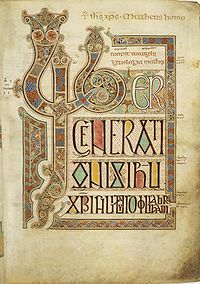
Lindisfarne Gospels
About this schools Wikipedia selection
SOS Children, an education charity, organised this selection. See http://www.soschildren.org/sponsor-a-child to find out about child sponsorship.
The Lindisfarne Gospels is an illuminated Latin manuscript of the gospels of Matthew, Mark, Luke and John. The manuscript was produced on Lindisfarne in Northumbria in the late 7th century or early 8th century, and is generally regarded as the finest example of the kingdom's unique style of religious art, a style that combined Anglo-Saxon and Celtic themes, what is now called Hiberno-Saxon art, or Insular art. The manuscript is complete (though lacking its original cover), and is astonishingly well-preserved considering its great age.
History
The Lindisfarne Gospels are presumed to be the work of the monk named Eadfrith, who became Bishop of Lindisfarne in 698 and died in 721. Current scholarship indicates a date around 715, and it is believed they were produced in honour of St. Cuthbert. The Gospels are richly illustrated in the insular style, and were originally encased in a fine leather binding covered with jewels and metals made by Billfrith the Anchorite in the 8th century. During the Viking raids on Lindisfarne, however, this cover was lost, and a replacement made in 1852. The text is written in insular script.
In the 10th century an Old English translation of the Gospels was made: a word-for-word gloss inserted between the lines of the Latin text by Aldred, Provost of Chester-le-Street. This is the oldest extant translation of the Gospels into the English language.
The Gospels were taken from Durham Cathedral during the dissolution of the monasteries, ordered by Henry VIII, and were acquired in the early 17th century by Sir Robert Cotton from Thomas Walker, Clerk of the Parliaments. Cotton's library came to the British Museum in the 18th century, and from there to the British Library in London.
Current Controversy
A controversial campaign exists to have the gospels housed in the North East of England, a move vigorously opposed by the British Library and condemned by international scholars. Several possible locations have been mooted, including Durham Cathedral, Lindisfarne itself or one of the museums in Newcastle upon Tyne or Sunderland. A modern facsimile copy of the Gospels is now housed in the Durham Cathedral Treasury, which can be seen by visitors.

